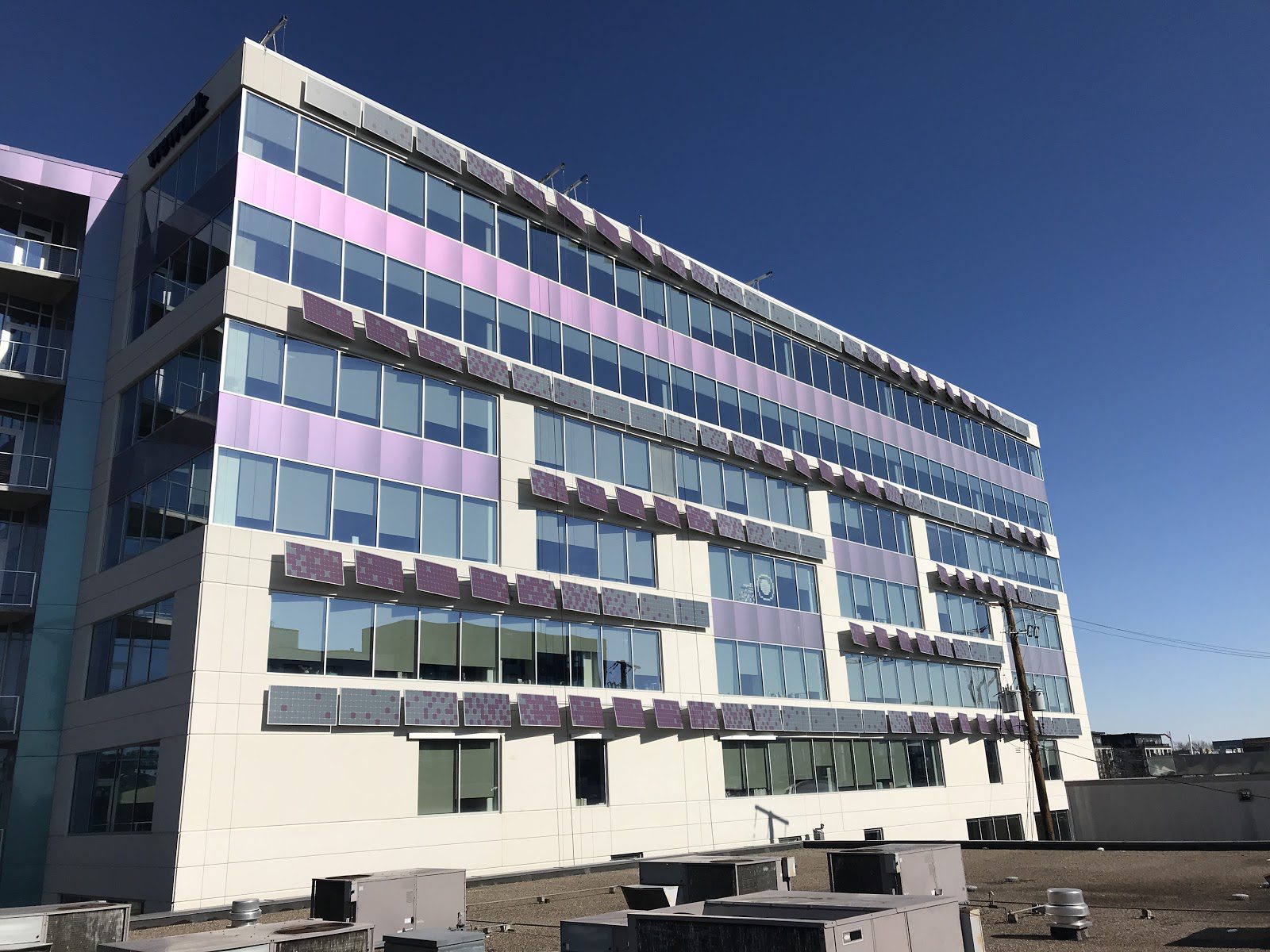MoZaic East is changing the way we see solar panels. The office and retail building in Minneapolis’ Uptown neighborhood now includes 112 colorful solar panels along the face of the structure. Designed by American companies All Energy Solar and Sistine Solar, these customized solar panels feature grey, purple and blue patterns, taking the once-drab utilitarian look of solar panels to a stunning new look. These wavy ribbons of color, a clever nod to Dutch artist Piet Mondrain, run the entire length of the project, between the rows of office buildings. It’s public art and sustainability all in one, versatile and fun, and there’s no doubt it’s a trend to watch for in the future.
The goal behind the design was that an aesthetically-pleasing visual will change the way other designers and architects see solar panels. Plus, the panels can be tilted away from the building, or even skyward, to harness the maximum solar energy based on the sun’s location in the sky. The design was a team effort from artists, engineers, designers, and architects and will clearly pave the way for intelligent and artistic synthesis of form and function. “At Ackerberg, we pride ourselves on creating inspired, sustainable urban environments,” Mike Munson, Ackerberg’s Development Manager said in a press release. “MoZaic East was constructed with all things sustainable in mind. Traditional solar projects are likely found in a field or on a rooftop. This project is anything but traditional. Instead, we envisioned an artful, colorful solar installation in the heart of Uptown. With grant funds from the Met Council for a highly visible and innovative solar strategy and creative vision of our project team, we were able to bring this vision to life.”

MoZaic East has the city of Minneapolis to thank as well. “Traditional solar projects are likely found in a rural field or on large, flat building roofs; but this solar project is anything but traditional,” Munson told Clean Energy in an interview from the MoZaic East Building. “Instead we envisioned an artful, colorful solar demonstration on MoZaic East’s southern façade to maximize solar power generation.” The 43-kilowatt project came together after the building’s developer, the Ackerberg Group, received a grant from the regional Twin Cities planning organization, the Metropolitan Council. In addition to the visual pop, the building offers numerous sustainable features such as a green roof, bike storage, and electric charging stations, earning a gold level rating from the U.S. Green Building Council’s Leadership in Energy and Environmental Design (LEED) program.
“It’s safe to say that MoZaic East is the world’s first of its kind – there hasn’t been another façade that involves using multiple colors and designs and these multiple offset angles,” Senthil Balasubramanian, Sistine Solar CEO and Founder said in that same press release. “This building is undoubtedly a pivotal point for companies who have expressed interest in going green and harnessing solar, but who don’t want their buildings to be marred by the solar panels’ bulky visuals. Sistine Solar has been hard at work on developing customized panels for both homes and commercial buildings. These covers have already become popular with homeowners in historic districts or neighborhoods with homeowner association restrictions that require any updates to match the style of their shingles. This move to commercial buildings is a big one.”
The MoZaic East panels are a gorgeous example of Sistine Solar’s SolarSkin technology, the world’s most efficient aesthetic solar technology, developed specifically to achieve the integration of solar, art, and architecture to convert what are traditionally visually uninteresting solar modules, into creative canvas space. Each “skin” is a fully customizable graphic overlay that can be imprinted with any artwork and applied to any solar module. It enables businesses to go solar while celebrating their commitment to sustainability in a visual way by infusing original artwork, logos, or brand colors. In an ever-changing world where fossil-fuel energy markets are regularly volatile, companies are looking more and more to reliable and affordable clean energy. Solar is an easy answer (one that comes with a 26 percent federal tax credit), and now buildings like MoZaic East are redefining the look of solar as part of a structure, making it not only good for the planet but pleasing to the eye. The revolutionary design represents a challenge to future developers to work with their community and redefine what clean technology looks like in the commercial sector. Munson concluded, “As global citizens, we have a duty to work to drastically reduce our carbon footprint. We hope this urban solar project can challenge other developers to think out-of-the-box when it comes to sustainability.”





